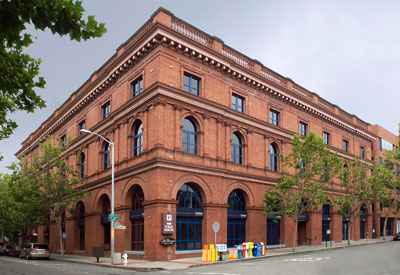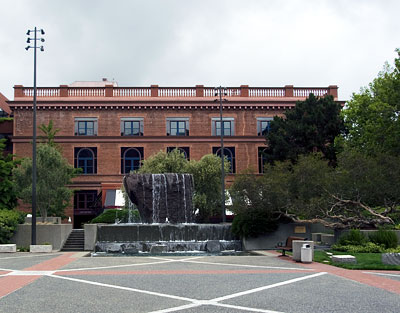San Francisco Landmarks
Italian Swiss Colony Warehouse
1265 Battery Street
Built 1903
Statement of Significance
The Italian Swiss Colony Building, designed by Hemenway and Miller, is one of the finest examples of industrial warehouse architecture remaining in the Northern Waterfront. Once common throughout the area, many of the warehouses have vanished under the wrecker's ball.
The façades on Battery and Greenwich Street suggest an homage to the palazzi of Italy.
Source: City Planning Commission resolution dated October 14, 1976.

Andrea Sbarboro was born in Genoa, Italy, in 1839 and migrated to San Francisco at the age of 13. He worked for twenty years in his brother's grocery, before establishing his own store.
The financial collapse of 1873 gave rise to the formation of mutual loan associations. Sbarboro founded five of these groups which financed over 2,500 homes in the Bay Area.
In 1881, Sbarboro was instrumental in founding the Italian Swiss Agricultural Association, a land-ownership cooperative functionally similar to a mutual savings and loan society.
The Association would purchase land and raise grapes for sale. Investors would be allowed to subscribe for a percentage of shares with the remaining shares reserved for the vineyard workers. Each worker would be required to purchase a minimum of five but not more than fifty shares.
When the prospective workers refused to accept the mandatory purchase of shares, the cooperative plan was abandoned and the association became the Italian Swiss Agricultural Colony, a commercial enterprise with membership restricted to those of Italian extraction who had attained American citizenship or filed their intention to do so. (It was once open similarly to Swiss because an Italian-Swiss was on the Board of Directors, but none applied.)
Forty sites were inspected before the 1500-acre Truett sheep ranch four miles south of Cloverdale was purchased on November 8, 1881, for $25,000. The site was named Asti after one of the finest wine regions in the Piedmonte province of northern Italy.
In its early years, the Colony faced countless crises and the first grapes did not reach San Francisco until 1887. Unfortunately, that year saw the market glutted and the price of grapes tumbled to about one-quarter of the price originally anticipated when the Colony was formed.
Source: Adapted from City Planning Commission resolution dated October 14, 1976.

In the early 1980's, the warehouse was incorporated into the new Levi Strauss & Co. World Headquarters complex.
The ground floor is leased by a restaurant, a coffee shop, and other ventures open to the public.
Frederick Griffing's Ship lies buried somewhere under the plaza.

